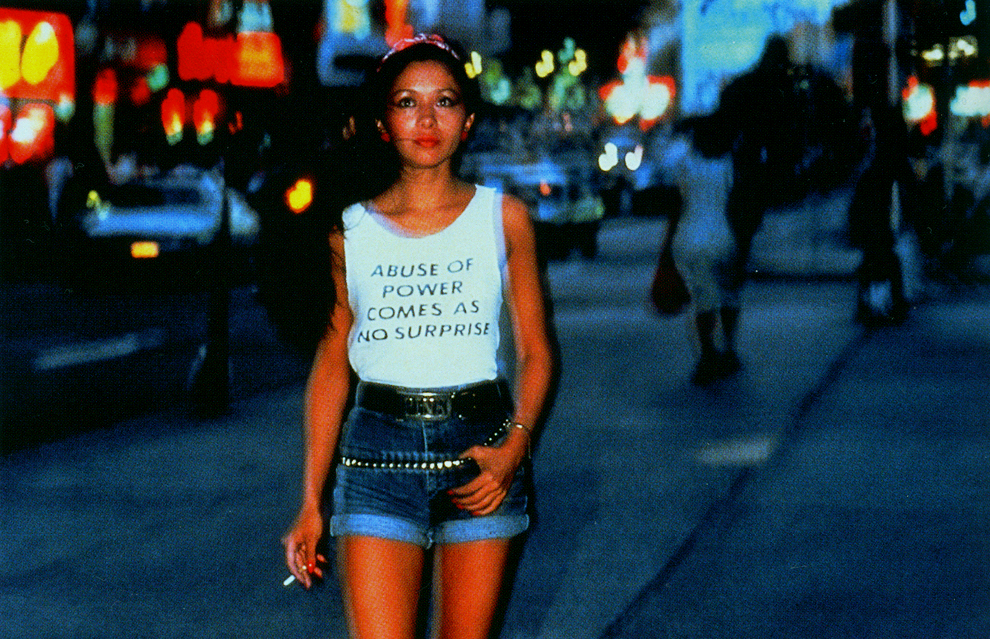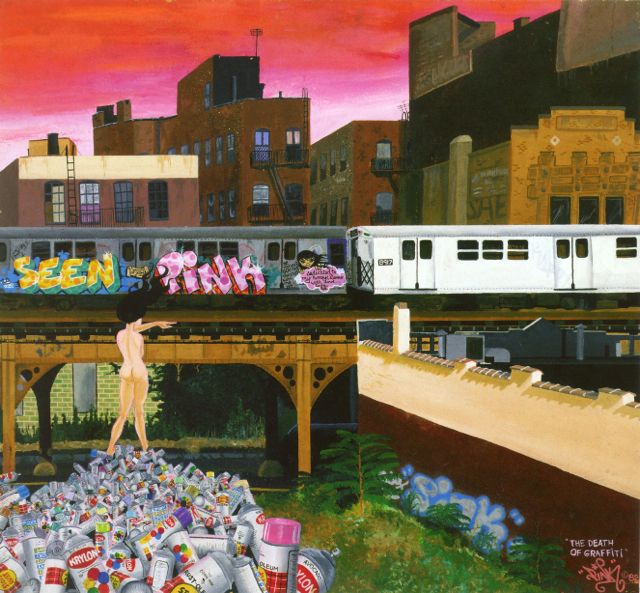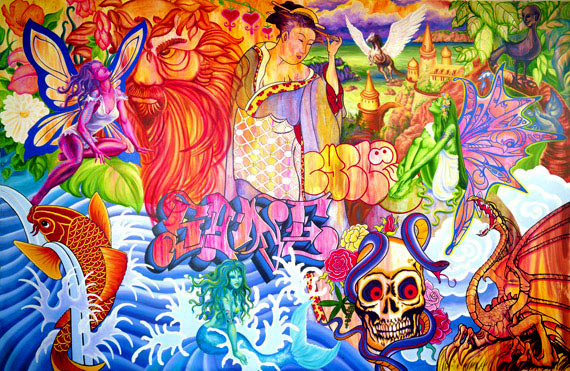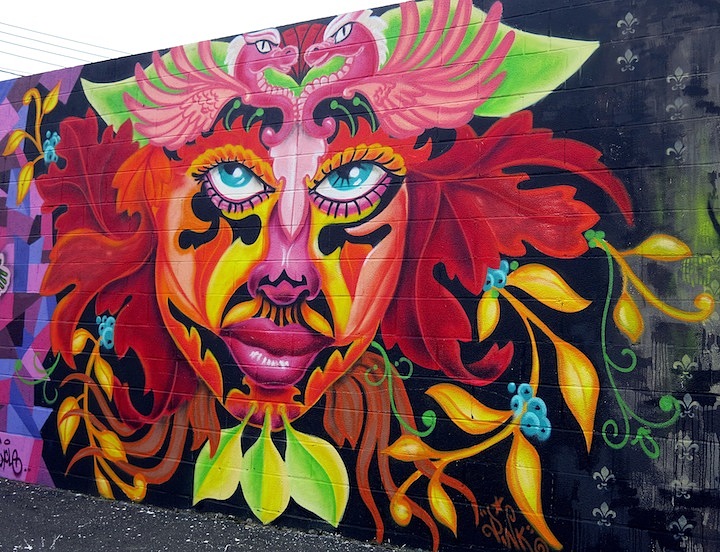By Nijla Mu’min
***In celebration of our upcoming release of BOMB IT 2, we’re featuring this exclusive interview with BOMB IT artist Lady Pink. The interview was conducted by our social media manager and emerging writer/filmmaker, Nijla Mu’min. ***
————————————————————————————————-
Graffiti/ Fine Artist Lady Pink knows her stuff. With a career spanning over 30 years, hundreds of canvasses, and walls, her knowledge of the art form is expansive, but also grounded in its tough realities. I caught up with the New York -based artist over Skype where she candidly discussed the first women of graffiti, the dangers of public work, and the current threat of the Vandal Squad (the Graffiti Police) on her life.
NM: Can you talk about any recent work, any specific work, and what kind of themes you’ve explored –
LP: I do a yearly mural project with the students of Frank Sinatra School of the Arts and we did that just a couple of weeks ago. Paintings- I haven’t really been doing too many for myself. I’ve actually taken the last couple of years off from too many projects since I’ve been going strong for 32 years and it gets a little tiring.
I don’t retain memory of anything I’ve done.
NM: Well you do so much so I think’s that totally fine… But there’s a piece you did called The Death of Graffiti that I really appreciate and has a lot of meaning. What were you trying to convey with that?
LP: I’ve painted hundreds and hundreds of canvases, so I have absolutely no idea what you’re talking about. What piece?
NM: It’s a picture of two subway trains- one of them has graffiti on it and the other one is white-
LP: I painted that when I was about 19 years old and I have absolutely no memory of painting it or what inspired me. The white trains were called white elephants and they came out in the early 80’s, someone painted them white, and we all thought they were a great big canvas for us all to work on, so I think I painted that white train there as soon as it just appeared.
The little girl standing on the mountain of spray paint, that would be me. I always had a lot of spray paint, like a mountain of spray paint. And I think the white train rolling by she’s pointing and saying “Oh my God, look at that white thing we can paint.” I don’t know why it’s titled The Death of Graffiti, maybe with the appearance of the white trains, we thought it would all vanish.
NM: Thank you. I would’ve never known about that information-
LP: The stories that I do in my paintings- I don’t really care if people understand what I’m saying or if they get what I’m saying. It’s not that important. It’s more important that I need to get something off my chest and I need to say something. And folks interpret my work in all kinds of weird ways.
NM: I was actually doing some other research and saw that your work takes on meaning for a lot of feminists, and women. You use the female body in a lot of your murals and artwork. Can you talk more about your views on being viewed as a feminist artist in that way?
LP: I have little control of what people label me. I’m not really much of a feminist, but people label me feminist and they see that in my work. I just like to do the female form because it looks better. It’s as simple as that. It’s much easier to draw. Guys are not that interesting. So you can do the shape of a woman and do all kinds of different things.
I’m not really much of an activist so I don’t see why people put me in that sort of a role. I just do what I do and go about my business, being a strong female so folks seem to think that I’m a role model in that way. I like to speak on women’s issues because they are relevant to me and in my life. The sexism that I’ve encountered, it’s not like I’m trying to be a feminist per se but I’m just speaking out about the injustices going around that women and children and minorities endure. My artwork deals with political issues, social issues, and all kinds of commentary that I like to make. I don’t necessarily do that in my public work because you just cant do that. But private work is different.
NM: You said for your public work versus the private work, that it’s different. Is that more of commissioned work that you get that you don’t explore those issues-
LP: No, it has to do with the fact that you can’t put a political or social statement in the street without having it be destroyed. You can’t get controversial and expect the building owner to stomach your message. You get harassed by their neighbors, and the wall can be destroyed by the opposing view. It’s not such a liberal city like that. Your private work, the fine art – you can paint whatever you want- disgusting, offensive, obnoxious, or anything that you want. It’s all good. Public work has a responsibility. It has to be family friendly, you have to take the community into consideration, this isn’t just a free for all where you can drop whatever artwork you want. You have to have some type of sensibility to the community.
NM: Thank you for that perspective and I think it applies to a lot of different artists across genres.
LP: With commissioned work and you’re working for a client, it’s what they’re getting, so it could be something controversial on their very own building or it could be cheesy, tacky, tasteless, and you don’t have to sign your name. So commissioned work is different. You are working for a client and you might be doing things that normally you would never do.
NM: When you started in graffiti, I’ve read that there weren’t many women involved in the graffiti scene. Do you think the presence of women in the scene has increased and why do you think so? Do you think you’ve influenced the growth of women in graffiti?
LP: As the times have changed and feminism has caught up with society, a lot of females are into street art and graffiti because they’re just being made stronger, tougher, sturdier, and they’re not all feminine and dainty and delicate and need to be protected by some man. Girls are braver and they are just as foolish and reckless as the next guy and they’re out their showing their thing. And I think it’s a cross-section of our society- you see women in sports, women in the military, women invading every aspect of our world and the same thing with graffiti- they can paint large, they can express themselves just as boldly as any guy and there’s nothing holding them back. I’d like to think I set an example earlier on that no matter what size you are or gender or anything, it just takes a lot of dedication and a lot of courage and a lot of heart to get this done, and a lot of women have followed suit. I’m certainly not the very first one.
There was a lot of ladies in the 1970’s that painted graffiti in New York- actually there were not a lot of ladies but by the time I came around in ‘79 they were all gone, they had all stopped and finished. The shelf life of a graffiti writer is anywhere from 2-5 years and they tend to have to grow up and have move on with life and get a job, go to college or something.
But for a lot of us girls they set an example of how courageous and great and reckless you can be- Barbara ’62, Eva ’62, Charmin and Stony, and all these girls, and they ran around in groups, crews of 3, 4, and 5 or even more because the streets were so unsafe in the 1970’s in NY, there was a lot of crime, so they ran in groups and they had clever little names for their crews and they had the protection of other crews. There were other females, but I had staying power. I stuck around long and started out small, going to bigger and better things.
But most of my achievements are above ground. From 1980-1985 and even in 1981 I’d been exhibiting in galleries and doing projects, and traveling around the world doing all kinds of things as a teenager. I was already booked with exhibits and things that I couldn’t finish my senior year of high school.
NM: When I do research for the documentary and I research street art, I get very different search results and I find that the term street art is a lot more accepted, and then graffiti is a lot more associated with crime. I wanted to see if you thought there’s a difference between street art and graffiti, and how that difference came about and how they got separated like that? Do you consider yourself a street artist?
LP: Absolutely not. That is a label that other people put on us. I’m not street artist. A street artist is a person who goes around doing illegal stuff in the street. I don’t do that and never have. I’ve had artwork in the street but that’s public artwork and it’s called murals and it’s done with permission, mostly funded, and it has nothing to do with street art.
A street artist is a person who’s charged for vandalism, for destroying somebody else’s property, but a street artist works in different mediums. They do not specialize in fonts and letters and names, and style, and spray paint the way we do. They work in different mediums with everything from chalk and paint and rubber bands and soldering wood and glass and metal, and anything goes. Whatever medium they can imagine, and they get arresting for knitting and it’s so much fun. You can’t help but admire their spirits because we’re cut from the same cloth, but they don’t have the same kind of community- the kind of support system that graffiti writers have. They are more isolated and they don’t run in groups and crews.
And again, the different medium thing is the biggest difference. We specialize and spend years developing style and letters, and hoping to apply this on some sort of train or bus that moves and rolls, and the last alternative is to paint it on a wall. Most strive to do it illegally, to put up their name and get fame that way. Street artists, they’re just kooky and crazy and they do the most bizarre stuff, and the fact we can all get arrested and charged for vandalism makes us similar.
I can train anyone to be a street artist, having to go out at night and do some vandalism by altering the landscape out there when you’re not supposed to, but with graffiti, it takes years of studying in order to train a proper criminal, because if we’re also teaching graffiti as it is, you’re teaching someone to be a criminal, to evade the police, to lie to your family, to steal the spray paint, and run around like a ninja playing cops and robbers. You need court, bail money, you need a lawyer, these things that most Hip Hop people or entertainers don’t really have to be concerned with. They are just entertainers. The graffiti writers are criminals. They run around breaking the law and that’s what they strive for. If that’s not what they strive for, then they can be like Hip Hop artists, because they don’t have to break the law and it’s a lot people like that, and a lot of women like that.
They won’t break the law. They just excel at the styles, they can use the spray paint, and do the lettering, the characters and the get along with all the other graffiti writers because they’re just in general very nice girls. They’re pretty and everyone wants them around but they don’t break the law. And you can’t be called a graffiti artist if you haven’t actually broken the law. Those are the differences but they’re all charged for vandalism and go to the same jails, and we can all exhibit the same gallery and be called street artists and that’s fine. People can label whatever they want to label us and we have no control over that.
NM: Okay. Is there anything going on right now in the news that impacts you. Or, that could relate to your art in any way?
LP: We’re in a bit of disarray here. We had a police raid here a few weeks ago – a month ago and they took all of our stuff, which is why my computer is gone and missing. They charged my husband with graffiti and they took off with all of my spray paint books and photos and computers, art and all kinds of things. And they charged him with something that he had nothing to do with. None of us had anything to do with. A bunch of street artists did an abandoned subway station in Brooklyn and they put out a book, the Underbelly project, and suddenly the police were at my door and they came in with shields and helmets and guns and it was a dozen cops and a SWAT team, and it was nothing I could do about it, and they took all of my stuff.
Then they’re charging my husband with a couple of felonies. The Vandal Squad- the Graffiti police have a way of harassing and intimidating artists by getting warrants, getting into their house, getting all their stuff. They did this to us 10 years ago and it took us about a year to get all of our stuff back, and there were no charges brought up at all. This time they’re just making something up- part of some street art project that some artists did and the book is called We Rule The Night, and we have pay a lawyer to defend ourselves and to get our stuff back which is my main computer, my laptop, all my artwork, my slides of all of the images I’ve done my whole life, my CD’s, my illustrations, and they just filled up an entire van full of our stuff and my options are- yeah, I could do some artwork trashing those guys, I did a mural and painted a little bit of a pink piggy cop, but you can’t really fight the cops once they’re like the mob. They are all powerful and they can mess with you and fuck with you, and invade your home.
So, now I’m in the process of moving out of here, I bought this house 10 years or so and now I have to move because if the police can get a warrant and so easily invade my home because of some project some street artists did that I’ve never even heard of, and they’re at my door, taking stuff off my walls, with all my spray paint so the projects I’ve done lately have been like a big blur. I don’t have the materials, I don’t have the paint, I don’t have the computer, I don’t have the equipment to do it.
So their whole purpose is to get my husband to lose his job. He’s a subway train operator and he’s been doing it for almost 5 years and they found out because of this project, that he was working there and now they are having him fired, and he’s in the process of being fired from his job and we have to move outside of NY where the Vandal squad doesn’t have jurisdiction to come into our house and take our stuff and arrest my husband, and try to arrest me too, but they’re waiting for me to give me something so I have to sit on my sofa and watch them rob me for hours and all these men trudging out of here with boxes. They took like 100 books out of my bookshelf. These are published books from the bookstore. I have a wonderful collection of graffiti books and street art books and all of that.
So I’d like to do paintings regarding that. That’s what’s been befallen us lately. But I’m in the process of buying a house somewhere else, moving, doing commissioned jobs, which requires no brain activity, and just do what people want, and get paid.
I don’t have time to start any of my own work and protest and scream out about these injustices, and I have to wait until this case is over and I’m not living in NY before I can start trashing the police. I’m not the only one that they get into their house. This has happened to as many other artists in New York that are suspected of alleged graffiti and all they did is organize an event or show or festival.
NM: I’m so sorry to hear that. I knew that police were very much against graffiti but this is crazy.
LP: What they told me before is that they want me to quit painting the murals outdoors and start going indoors to the little galleries and making more money that way, and to quit inspiring people by painting public art. Because I inspire people, and they think I inspire people to do vandalism but I inspire everyone- poets, photographers and everyone to work, and I inspire in good ways, and they say to just stay indoors with the galleries so this is how they harass and intimidate us and make stuff up.
I’m just a legitimate artist. I shouldn’t have to endure any of this.
NM: I don’t even know what to say.
LP: It’s not a game. Things get changed and destroyed. This isn’t a game. It’s not exactly Hip Hop. They are not playing with their lives like that. And we’re not responsible for what some street artists in the projects do. I don’t have anything to do with that. We shouldn’t have to answer to them.
NM: And with all the repercussions and life-changing events that come with being involved in the art form, what do you say when young people come to you- you work with a lot of young people- and they are building their life in graffiti or street art-
LP: I don’t teach them graffiti or street art. I teach them murals. I focus specifically on the artwork. I don’t teach them spray paint or none of that. I mostly work with students of Frank Sinatra school of the arts as I said, and these are art students who can already draw and paint. I work from that talent. I don’t ever teach them graffiti and some of those kids have whispered to me- can you take me to some wall, and I say absolutely not. We’re not going anywhere illegal and that’s out of the question.
That’s outside of my curriculum. I teach murals and that’s hard enough- how to get your little design on a wall, it’s a challenge. I don’t really practice my lettering to tell you the truth. I don’t worry about any of that. When I get commissioned for- its called corporate graffiti and its graffiti that’s styled and for customers and what not- I outsource the lettering to my husband and other guys who work with lettering and I’m more illustrational and I don’t keep up with the graffiti as much. My husband is more of a historian and archivist of the changing styles and personalities and politics.
NM: I appreciate the range in your work and thank you for talking to me today.
Nijla Mu’min is a writer and filmmaker from the SF Bay Area.





One of the better images I’ve seen lately